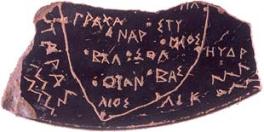 A Great Deal
A Great DealBack in 1955, the United States government conveyed to the State of Florida, 190,000 acres of streams, lakes, cotton and pine plantations, known as the
Blackwater River Forest. The cost? One dollar, plus an agreement that the land would be used for the public good forever.
Perhaps owing to the cheap price, the State of Florida never had the property surveyed, instead relying on maps from the early 1800s. While the maps are legally binding, many of the physical objects marking the property have long since been destroyed.
Retracing Old Maps Reveals A Modern Mess
As the
News-Press explains, with the property on all sides of the forest ripe for development, the state
Division of Forestry decided to have the forest surveyed to firmly mark its boundaries. The result has brought consternation to local property owners, many of whom have lived next to the forest for decades.
GCY Inc., the firm hired by the state to survey the forest, has been attempting to retrace the property lines shown on maps prepared by the General Land Office. The maps date from the 1820s through 1850s. In retracing the lines, the surveyors have found Blackwater River Forest's true boundaries run through people's bedrooms and porches. Dozens of homeowners and farmers who have occupied the land for generations have been told they are actually on state property. In one case, the gravestones in a church cemetery are actually located on the state's forest property.
No Easy SolutionsWhile state officials have shown no interest in digging up graves or forcing people from their homes, legal remedies to situation are not apparent.
In many instances where someone has encroached upon the property of another for decades, the encroaching party can claim title to the disputed land through the principle of
adverse possession. However, as I've
posted previously, adverse possession cannot be claimed against the government, so that offers no remedy.
Selling or just giving the land to the people that are occupying it doesn't seem to be an easy option either. The deed from the federal government to Florida prohibits the state from simply giving up the land. The deed states that if the land isn't used for public purposes, Blackwater "shall immediately revert to and become revested in the United States" government.
A Long HaulWhatever the final outcome, residents of the area appear headed for a long, drawn out process. In what is clearly an understatement, John Browne, with the Florida Bureau of Forest Management tells the News-Press, "What we've found is not real good, And were really just beginning."
 With Christmas right around the corner, you're probably wondering what to the get that pet-owner on your list. Well, don't worry, the people at GPS Tracks have got you covered. The company has just come out with GlobalPetFinder. The system combines global positioning system (GPS) technology with two-way wireless, to automatically locate the position of your lost pet. When your dog or cat runs off, It sends their position to your wireless device. It comes in your choice of either jet black or sour apple green. GlobalPetFinder will set you back $349.99, plus a monthly service fee of $17.99.
With Christmas right around the corner, you're probably wondering what to the get that pet-owner on your list. Well, don't worry, the people at GPS Tracks have got you covered. The company has just come out with GlobalPetFinder. The system combines global positioning system (GPS) technology with two-way wireless, to automatically locate the position of your lost pet. When your dog or cat runs off, It sends their position to your wireless device. It comes in your choice of either jet black or sour apple green. GlobalPetFinder will set you back $349.99, plus a monthly service fee of $17.99.
































